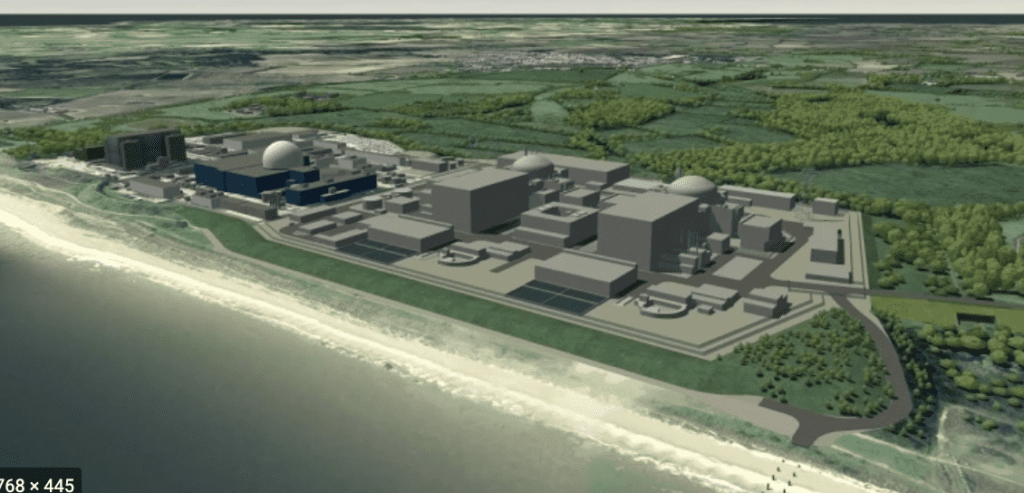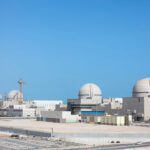The UK government will bolster a proposal to build Sizewell C with a £679 million ($815 million) investment, giving the twin EPR nuclear power plant project—a combined 3.2 GW—new flexibility to proceed.
The UK Department for Business, Energy, and Industrial Strategy (BEIS) on Nov. 29 said that with the final investment decision, it intends to become a 50% partner with EDF, a company owned by the French state. The investment also allows for China General Nuclear’s (CGN) to exit from the project, providing for buy-out costs, taxes, and commercial arrangements. “The Government will work with the project company to seek to attract new third-party investment to help finance the project’s construction and operation,” it said.
A Historic Decision
The UK government’s participation in the large-scale nuclear plant marks a historic decision that underscores momentum for new nuclear. The UK has a 60-year nuclear power legacy, building some of the world’s first commercial nuclear reactors at (Calder Hall) at Sellafield in 1956. However, the government has not backed a nuclear project in more than three decades.
The country’s current nine-reactor fleet—a combined 6.5 GW—generates about 15% of its electricity. Most of these reactors, however, are advanced gas-cooled reactors (AGRs) built between 1983 and 1995. The newest in the fleet is EDF’s 1.4-GW Sizewell B, a Westinghouse 4-loop pressurized water reactor based on the Standardized Nuclear Unit Power Plant System (SNUPPS) model. Sizewell B, which was approved for construction in 1987, marked the UK government’s last direct investment in a new nuclear project.
The country meanwhile has only one nuclear project under construction comprising two EPR reactors at the 3.2-GW Hinkley Point C plant in Somerset, southwest England. EDF, Hinkley Point C developer, has proposed a replica project at Sizewell C in Suffolk, eastern England. Sizewell C will be built next to Sizewell B, which began operating in 1995. The government approved proposals for Sizewell C and granted the project a Development Consent Order (DCO) in July 2022.

Part of a Net Zero and Energy Security Strategy
BEIS said its decision on Tuesday stems from an objective first set out in an energy white paper issued in 2020. The government’s commitment to reaching a final investment decision on “at least one large-scale nuclear power station” over the current parliamentary period has since been included in the government’s Net Zero and British Energy Security Strategies.
However, the UK intends to build other nuclear plants as part of an effort to re-establish its nuclear leadership and boost its low-carbon energy security. An energy strategy unveiled on April 6 prominently calls on the UK to “reverse decades of myopia” and target adding up to eight new nuclear reactors to its six existing reactors—potentially tripling its nuclear capacity to up to 24 GW by 2050. The effort would boost nuclear’s UK generation share from the current 15% to 25%, the government had then said.
“Today’s approval comes alongside the government’s continued commitment to develop a pipeline of new nuclear projects, beyond Sizewell C,” BEIS noted on Tuesday. “To support this, the UK is working at pace to set up Great British Nuclear, the vehicle tasked with developing a resilient pipeline of new nuclear builds, with an announcement expected early in the new year.” On Tuesday, the government also confirmed its commitment to set up Great British Nuclear, “an Arms’ Length Body (ALB)” that will “develop a resilient pipeline of new builds,” BEIS said.
BEIS said “the driving force” behind its long-term plans will be the Energy Security Bill, which is “being driven forward “in Parliament. The efforts will “put in place powers to shield Britain from global forces and secure energy for future generations,” it said.
“Together with our drive to improve the nation’s energy efficiency, this package will help to permanently bring down energy bills and stop Britain being at the mercy of global gas prices beyond our control,” noted Chancellor of the Exchequer Jeremy Hunt.
EDF: EPRs Will Benefit from Experience
EDF applauded the government’s “big vote of confidence in Sizewell C.” Simone Rossi, CEO of EDF Energy, underscored improved project costs for the EPR plant. “Sizewell C will build on the achievements of Hinkley Point C and replicating its design will provide more certainty over schedule and costs,” he said. “It will deliver another big boost to jobs and skills in the nuclear industry and provide huge new opportunities for communities in Suffolk. New nuclear will protect Britain from volatile global gas markets and help keep bills under control for the country’s homes and businesses.”
According to EDF, EPRs—originally known as European Pressurized Water Reactors—are a “good choice” for Sizewell C, given that the technology is already operating at Taishan in China. The company acknowledged that EPR projects it has spearheaded in France (Flamanville) and in Finland (Olkiluoto) have been dramatically delayed by cost and schedule overruns, but it said those issues were because they were new builds that came “after a long gap in nuclear construction. Skills and experience had been lost,” it said. “In addition, those projects began construction before the detailed design had been completed. This meant complex alterations had to be carried out once construction was underway.”
Meanwhile, though two EPRs at Taishan in China began successful commercial operation in 2018 and 2019, Taishan 1 is currently shut down for maintenance “after minor damage to a very small number of fuel rods,” EDF acknowledged. “It’s not unusual to experience minor issues with fuel in the early life of a reactor.”
Construction at Hinkley Point C, which began in 2016, “is making good progress” and is benefiting from experience at other EPRs. “Improvements in construction between the first and second reactor units are demonstrating the value of replication,” it said.
“Sizewell C will be the 7th and 8th EPR units in the world and will benefit from a large body of experience from construction and operation of the rest of the EPR fleet,” the company said. “The project will have a stable design, an experienced workforce and supply chain, and a well-tested schedule. We will have a very good understanding of project risks and how to mitigate them.”
—Sonal Patel is a POWER senior associate editor (@sonalcpatel, @POWERmagazine).










